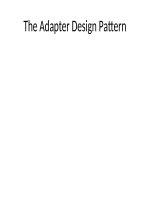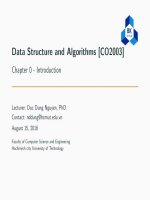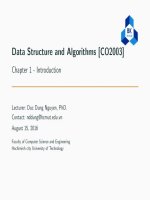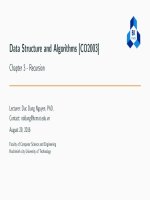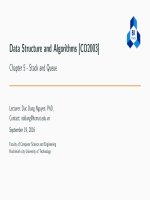C++ programming program design including data structure 7th ch09
Bạn đang xem bản rút gọn của tài liệu. Xem và tải ngay bản đầy đủ của tài liệu tại đây (551.53 KB, 22 trang )
Chapter 9:
Records (structs)
Objectives
•
In this chapter, you will:
– Learn about records (structs)
– Examine various operations on a struct
– Manipulate data using a struct
– Learn about the relationship between a struct
and functions
– Examine the difference between arrays and
structs
C++ Programming: Program Design Including Data Structures, Seventh Edition
2
Objectives (cont’d.)
– Discover how arrays are used in a struct
– Learn how to create an array of struct items
– Learn how to create structs within structs
C++ Programming: Program Design Including Data Structures, Seventh Edition
3
Records (structs)
•
struct: collection of a fixed number of components
(members), accessed by name
– Members may be of different types
•
Syntax:
C++ Programming: Program Design Including Data Structures, Seventh Edition
4
Records (structs) (cont’d.)
•
A struct is a definition, not a declaration
– Must declare a variable of that type to use it
C++ Programming: Program Design Including Data Structures, Seventh Edition
5
Records (structs) (cont’d.)
C++ Programming: Program Design Including Data Structures, Seventh Edition
6
Accessing struct Members
•
Syntax to access a struct member:
•
The dot (.) is called the member access operator
C++ Programming: Program Design Including Data Structures, Seventh Edition
7
Accessing struct Members (cont’d.)
•
To initialize the members of newStudent:
newStudent.GPA = 0.0;
newStudent.firstName = "John";
newStudent.lastName = "Brown";
C++ Programming: Program Design Including Data Structures, Seventh Edition
8
Assignment
•
Value of one struct variable can be assigned to
another struct variable of the same type using an
assignment statement
•
The statement:
student = newStudent;
copies the contents of newStudent into student
C++ Programming: Program Design Including Data Structures, Seventh Edition
9
Assignment (cont’d.)
•
The assignment statement:
student = newStudent;
is equivalent to the following statements:
student.firstName = newStudent.firstName;
student.lastName = newStudent.lastName;
student.courseGrade = newStudent.courseGrade;
student.testScore = newStudent.testScore;
student.programmingScore = newStudent.programmingScore;
student.GPA = newStudent.GPA;
C++ Programming: Program Design Including Data Structures, Seventh Edition
10
Comparison (Relational Operators)
•
Compare struct variables member-wise
– No aggregate relational operations allowed
•
To compare the values of student and newStudent:
C++ Programming: Program Design Including Data Structures, Seventh Edition
11
Input/Output
•
No aggregate input/output operations on a struct
variable
•
Data in a struct variable must be read or written
one member at a time
•
Example: output newStudent contents
C++ Programming: Program Design Including Data Structures, Seventh Edition
12
struct Variables and Functions
•
A struct variable can be passed as a parameter by
value or by reference
•
A function can return a value of type struct
C++ Programming: Program Design Including Data Structures, Seventh Edition
13
Arrays versus structs
C++ Programming: Program Design Including Data Structures, Seventh Edition
14
Arrays in structs
•
Two items are associated with a list:
– Values (elements)
– Length of the list
•
Define a struct containing both items:
C++ Programming: Program Design Including Data Structures, Seventh Edition
15
Arrays in structs (cont’d.)
C++ Programming: Program Design Including Data Structures, Seventh Edition
16
Arrays in structs (cont’d.)
C++ Programming: Program Design Including Data Structures, Seventh Edition
17
structs in Arrays
•
Example:
C++ Programming: Program Design Including Data Structures, Seventh Edition
18
structs in Arrays (cont’d.)
C++ Programming: Program Design Including Data Structures, Seventh Edition
19
structs within a struct
C++ Programming: Program Design Including Data Structures, Seventh Edition
20
Summary
•
struct: collection of a fixed number of components
•
Components can be of different types
– Called members
– Accessed by name
•
struct is a reserved word
•
No memory is allocated for a struct
– Memory when variables are declared
C++ Programming: Program Design Including Data Structures, Seventh Edition
21
Summary (cont’d.)
• Dot (.) operator: member access operator
– Used to access members of a struct
• The only built-in operations on a struct
are the assignment and member access
• Neither arithmetic nor relational
operations are allowed on structs
• A struct can be passed by value or
reference
• A function can return a value of type
struct
• structs can be members of other structs
C++ Programming: Program Design Including Data Structures, Seventh Edition
22

